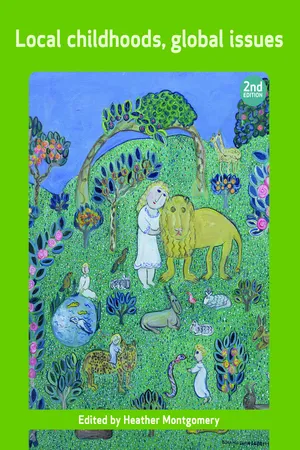
- 336 pages
- English
- PDF
- Available on iOS & Android
Local Childhoods, Global Issues
About this book
Although the plight of children can sometimes seem grim, there are positive indicators. This interdisciplinary textbook examines children's lives across the world, acknowledging the great differences as well as points of comparison, between childhoods in different contexts. It examines children's use of their own resources and coping strategies, revealing that few children are passive victims of fate, helplessly awaiting rescue. The book considers the problems caused by poverty, social inequality, ill-health and violence and emphasises that these are challenges for children everywhere, not just those in the poorer countries of the world. A key feature of the book is the children's voices which feature prominently in many chapters in interviews and research conducted by the authors. This well-presented and engagingly written book is an ideal introduction for undergraduates interested in contemporary global childhoods.
Frequently asked questions
- Essential is ideal for learners and professionals who enjoy exploring a wide range of subjects. Access the Essential Library with 800,000+ trusted titles and best-sellers across business, personal growth, and the humanities. Includes unlimited reading time and Standard Read Aloud voice.
- Complete: Perfect for advanced learners and researchers needing full, unrestricted access. Unlock 1.4M+ books across hundreds of subjects, including academic and specialized titles. The Complete Plan also includes advanced features like Premium Read Aloud and Research Assistant.
Please note we cannot support devices running on iOS 13 and Android 7 or earlier. Learn more about using the app.
Information
Table of contents
- Introduction
- Chapter 1 Interventions and ideologies
- 1 Introduction
- 2 Why intervene in children's lives?
- 3 Rescuing the innocent
- 4 Children and welfare states
- 5 Children as rights-bearers
- 6 Conclusion
- References
- Reading A Sweet childhood lost
- Reading B Crack babies
- Reading C The cycle of child displacement in the Russian north
- Chapter 2 Children, poverty and social inequality
- 1 Introduction
- 2 Definitions of poverty
- 3 Impacts of child poverty
- 4 Social inequality
- 5 Conclusion
- References
- Reading A A child's eye view of poverty
- Reading B Nothing bad intended
- Reading C Suffering child: an embodiment of war and its aftermath in post-Sandinista Nicaragua
- Chapter 3 Achieving health for children
- 1 Introduction
- 2 Child health matters
- 3 What is good health?
- 4 The social determinants of health: the role of social inequality
- 5 Achieving health in practice
- 6 Conclusion
- References
- Reading A The spirit catches you and you fall down
- Reading B the obesity epidemic: medical and ethical consideration
- Reading B Death without weeping: the violence of everyday life in Brazil
- Chapter 4 Children and violence
- 1 Introduction
- 2 Definitions of violence
- 3 Violence in the home
- 4 Violence at school
- 5 Violence in the community
- 6 Conclusion
- References
- Reading A Violent youth or violent school
- Reading B Political transition and youth violence in post-apartheid South Africa
- Reading C A long way gone
- Chapter 5 Resilience and well-being
- 1 Introduction
- 2 What is resillience?
- 3 What makes children resilient?
- 4 What is well-being and why is it important?
- 5 What's wrong with well-being?
- 6 Conclusion
- References
- Reading A Seen but not heard: refugee children and models for intervention
- Reading B Vulnerable but invincible
- Reading C What is wrong with children's well-being in the UK?
- Chapter 6 Research on childhood issues as social problems
- 1 Introduction
- 2 The social construction of childhood problems
- 3 The role of research
- 4 Explaining a moral panic
- 5 Relations between researcher and researched
- 6 Conclusion
- References
- Acknowledgements
- Index